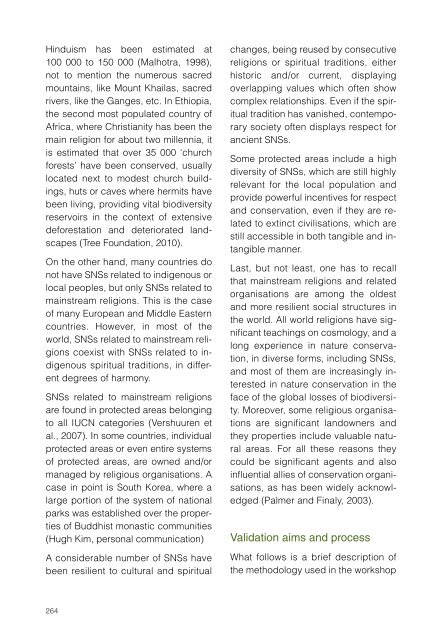The Diversity of Sacred Lands in Europe - IUCN
The Diversity of Sacred Lands in Europe - IUCN
The Diversity of Sacred Lands in Europe - IUCN
You also want an ePaper? Increase the reach of your titles
YUMPU automatically turns print PDFs into web optimized ePapers that Google loves.
H<strong>in</strong>duism has been estimated at<br />
100 000 to 150 000 (Malhotra, 1998),<br />
not to mention the numerous sacred<br />
mounta<strong>in</strong>s, like Mount Khailas, sacred<br />
rivers, like the Ganges, etc. In Ethiopia,<br />
the second most populated country <strong>of</strong><br />
Africa, where Christianity has been the<br />
ma<strong>in</strong> religion for about two millennia, it<br />
is estimated that over 35 000 ‘church<br />
forests’ have been conserved, usually<br />
located next to modest church build<strong>in</strong>gs,<br />
huts or caves where hermits have<br />
been liv<strong>in</strong>g, provid<strong>in</strong>g vital biodiversity<br />
reservoirs <strong>in</strong> the context <strong>of</strong> extensive<br />
deforestation and deteriorated landscapes<br />
(Tree Foundation, 2010).<br />
On the other hand, many countries do<br />
not have SNSs related to <strong>in</strong>digenous or<br />
local peoples, but only SNSs related to<br />
ma<strong>in</strong>stream religions. This is the case<br />
<strong>of</strong> many <strong>Europe</strong>an and Middle Eastern<br />
countries. However, <strong>in</strong> most <strong>of</strong> the<br />
world, SNSs related to ma<strong>in</strong>stream religions<br />
coexist with SNSs related to <strong>in</strong>digenous<br />
spiritual traditions, <strong>in</strong> different<br />
degrees <strong>of</strong> harmony.<br />
SNSs related to ma<strong>in</strong>stream religions<br />
are found <strong>in</strong> protected areas belong<strong>in</strong>g<br />
to all <strong>IUCN</strong> categories (Vershuuren et<br />
al., 2007). In some countries, <strong>in</strong>dividual<br />
protected areas or even entire systems<br />
<strong>of</strong> protected areas, are owned and/or<br />
managed by religious organisations. A<br />
case <strong>in</strong> po<strong>in</strong>t is South Korea, where a<br />
large portion <strong>of</strong> the system <strong>of</strong> national<br />
parks was established over the properties<br />
<strong>of</strong> Buddhist monastic communities<br />
(Hugh Kim, personal communication)<br />
A considerable number <strong>of</strong> SNSs have<br />
been resilient to cultural and spiritual<br />
changes, be<strong>in</strong>g reused by consecutive<br />
religions or spiritual traditions, either<br />
historic and/or current, display<strong>in</strong>g<br />
overlapp<strong>in</strong>g values which <strong>of</strong>ten show<br />
complex relationships. Even if the spiritual<br />
tradition has vanished, contemporary<br />
society <strong>of</strong>ten displays respect for<br />
ancient SNSs.<br />
Some protected areas <strong>in</strong>clude a high<br />
diversity <strong>of</strong> SNSs, which are still highly<br />
relevant for the local population and<br />
provide powerful <strong>in</strong>centives for respect<br />
and conservation, even if they are related<br />
to ext<strong>in</strong>ct civilisations, which are<br />
still accessible <strong>in</strong> both tangible and <strong>in</strong>tangible<br />
manner.<br />
Last, but not least, one has to recall<br />
that ma<strong>in</strong>stream religions and related<br />
organisations are among the oldest<br />
and more resilient social structures <strong>in</strong><br />
the world. All world religions have significant<br />
teach<strong>in</strong>gs on cosmology, and a<br />
long experience <strong>in</strong> nature conservation,<br />
<strong>in</strong> diverse forms, <strong>in</strong>clud<strong>in</strong>g SNSs,<br />
and most <strong>of</strong> them are <strong>in</strong>creas<strong>in</strong>gly <strong>in</strong>terested<br />
<strong>in</strong> nature conservation <strong>in</strong> the<br />
face <strong>of</strong> the global losses <strong>of</strong> biodiversity.<br />
Moreover, some religious organisations<br />
are significant landowners and<br />
they properties <strong>in</strong>clude valuable natural<br />
areas. For all these reasons they<br />
could be significant agents and also<br />
<strong>in</strong>fluential allies <strong>of</strong> conservation organisations,<br />
as has been widely acknowledged<br />
(Palmer and F<strong>in</strong>aly, 2003).<br />
Validation aims and process<br />
What follows is a brief description <strong>of</strong><br />
the methodology used <strong>in</strong> the workshop<br />
264













